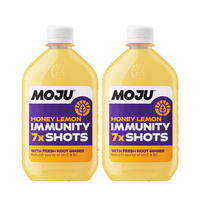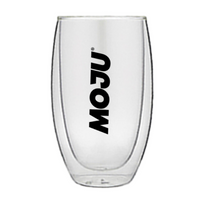Gut feeling can only take you so far. Sometimes, what you need are cold, hard facts. So, what’s the deal with digestive health? Why should we care about something as gross-sounding as bacteria? And most of all, WILL MOJU EVER STOP BANGING ON ABOUT IT?
The answer to that last one is a resounding ‘no’, for reasons that will soon become clear. Let’s put your microbiome under the microscope…
YOU SAY BIOME, I SAY BIOTA
The ecosystem in your gut can be referred to as both a microbiome or a microbiota. Essentially, they both mean exactly the same thing, and can be used interchangeably. What’s important is that either word is preceded with the word ‘gut’.
Why?
Well, the microbes making the ‘micro’ actually live all over your body – your nose, your mouth, your skin. Basically, anywhere our environment can access will become a home to a microbiome/microbiota.
The reason why your gut’s one gets mentioned a lot is because the largest proportion of these microbes can be found in the end part of your gut, known as the colon (or large intestine.) The density of this community is quite astounding – we’re talking trillions of microbial cells. It’s REAL cosy in there.
Just to put that into perspective, if you had all your microbiome removed (not that you want to) you’d shave off around 2-3kgs instantly. Bonus fun fact: 30-50% of your poo is microbes too. That’s one to share down the pub…
WHAT’S IT MADE OF?
Most of the microbiome is made of bacteria, but there are other life forms lurking around in there too. There’s the bacteria-like Archaea, as well as Eukaryotes (which are thought of as parasites) fungi, viruses and bacteriophages. The latter infect and kill bacterial cells, and actually outnumber bacteria by 10 to 1. It’s an interesting predator/prey dynamic going on in that gut of yours.
So in summary: the gut microbiome/microbiota is a densely complex ecosystem that interacts with us in a way that allows all the fantastic things that happen in the human body.
It’s a precious cargo to carry around – or are we the cargo? Some believe that we humans are nothing more than a fancy flask designed over the course of evolution to efficiently propagate the microbial culture from person to person, generation to generation…
Shall we move on before we collapse into existential crisis?
WHAT MAKES DIGESTIVE TRACT ONES DIFFERENT?
There’s actually distinct forms all along your digestive tract. In your mouth, you’ve got oral microbiota on your teeth and in saliva. These are different from the ones in your gut as they can deal with oxygen and hoover up nutrients your colonic bacteria won’t. Highly structured and not very mobile, they often grow in matts that live on teeth.
As you move down, there are microbes in your oesophagus (the tube connected to your throat) and stomach. These communities are neither very dense, dynamic or very well understood. They don’t interact with each other much, and are also specifically adapted to a different environment as the stomach is acidic.
Moving from the stomach to the small intestine, communities are better understood and more widely studied. But given that they’re awkward places to access for further investigation, they’re environments that are still pretty unknown.
Finally, we hit the motherlode: the colon. This is where the largest community resides, carrying out loads of metabolic activity, interacting with themselves and the host (… aka, us.) This community is the best studied as it is easily accessible compared to the stomach or small intestine.
(If you want an indication of how well your colon is faring down there, just check your poo.)
WHERE DOES MICROBIOTA COME FROM?
Given the womb is a sterile environment, we’re all completely bacteria-free, prior to birth. The moment a little bundle of joy enters the world, a new little ecosystem is born with it – and it’s every bit as dramatic as that sounds.
Imagine it like a new island rising from the ocean. One that had no species on it, then suddenly, it inspires a land-rush for this open territory. It’s intense stuff.
In fact, research shows that infants go through a complex process of microbiota ‘assembly’ over the first days, weeks, months and years of life. Of course, there’s still some big old shifts going on from childhood-adolescence-adulthood, but that first 0-1 year is the most dynamic – and when the most changes happen.
WHAT FACTORS FUEL THE CHANGE?
There are lots of different trajectories that the development process can take because the microbiota is so malleable, and can be affected by all sorts of factors in early life. For example: it makes a difference if a baby is born via c-section or vaginally. We’re aware that infants that are born by c-section have a gut microbiota that looks more like human skin than the mother’s vaginal or stool microbiota.
Babies that are born through the birth canal have initial colonization of the vaginal and stool microbiota of their mother. So, c-section babies or naturally birthed babies have very different microbiotas. Add to this if the infant is breast fed or formula fed, if they have a pet or not, if they have siblings or not, exposed to antibiotics or not. These are all factors that can change the development process and change the microbial identity and life.
The reason the gut health field is so interested in this area is because we understand from animal studies that depending on what microbes you get early in life can send the immune system, metabolism, and other parts of the biology in different development trajectories. Going back to the island analogy: what microbes colonised you early in life will completely dictate the future landscape.
WHAT DOES A HEALTHY MICROBIOME LOOK LIKE?
As you can probably see, this is a complex topic – and context matters a lot. What’s healthy for one person or population may not be healthy for another.
For that reason, there’s no single answer: but there are important considerations at least.
Of the traditional populations of humans that have been reviewed (like hunter-gatherers and rural agricultural communities) it would seem they are healthy and living quite different lifestyles to modern societies. Their microbiome looks vastly different to a healthy ‘developed world microbiome’.
For those of us subjected to the trials of modern living, it’s important to keep the healthy maintenance of gut health front of mind, as our diets simply don’t support it so easily. Adding products like MOJU’s Gut Health shots are just one way you can help support the trillions of bacteria who are crying out for delicious fibres to keep them sustained.




